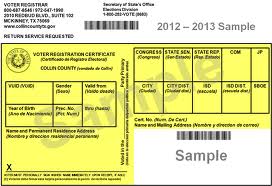From the Washington Post:
Election fraud happens. But ID laws are not aimed at the fraud you’ll actually hear about. Most current ID laws (Wisconsin is a rare exception) aren’t designed to stop fraud with absentee ballots (indeed, laws requiring ID at the polls push more people into the absentee system, where there are plenty of real dangers). Or vote buying. Or coercion. Or fake registration forms. Or voting from the wrong address. Or ballot box stuffing by officials in on the scam. In the 243-page document that Mississippi State Sen. Chris McDaniel filed on Monday with evidence of allegedly illegal votes in the Mississippi Republican primary, there were no allegations of the kind of fraud that ID can stop.
Instead, requirements to show ID at the polls are designed for pretty much one thing: people showing up at the polls pretending to be somebody else in order to each cast one incremental fake ballot. This is a slow, clunky way to steal an election. Which is why it rarely happens.
I’ve been tracking allegations of fraud for years now, including the fraud ID laws are designed to stop. In 2008, when the Supreme Court weighed in on voter ID, I looked at every single allegation put before the Court. And since then, I’ve been following reports wherever they crop up.
To be clear, I’m not just talking about prosecutions. I track any specific, credible allegation that someone may have pretended to be someone else at the polls, in any way that an ID law could fix.
So far, I’ve found about 31 different incidents (some of which involve multiple ballots) since 2000, anywhere in the country. If you want to check my work, you can read a comprehensive list of the incidents below.
To put this in perspective, the 31 incidents below come in the context of general, primary, special, and municipal elections from 2000 through 2014. In general and primary elections alone, more than 1 billion ballots were cast in that period.
Some of these 31 incidents have been thoroughly investigated (including some prosecutions). But many have not. Based on how other claims have turned out, I’d bet that some of the 31 will end up debunked: a problem with matching people from one big computer list to another, or a data entry error, or confusion between two different people with the same name, or someone signing in on the wrong line of a pollbook.
In just four states that have held just a few elections under the harshest ID laws, more than 3,000 votes (in general elections alone) have reportedly been affirmatively rejected for lack of ID. (That doesn’t include voters without ID who didn’t show up, or recordkeeping mistakes by officials.) Some of those 3,000 may have been fraudulent ballots. But how many legitimate voters have already been turned away?
So that’s at most two possibly fraudulent ballots per year nationwide that voter ID laws might have helped prevent. See why people say voter ID is a “solution” in search of a problem? The goal of voter ID legislation is to make it harder to vote, period. If we were really interested in protecting the integrity of the ballot, there are much bigger targets to aim for and much broader reforms that could be made, but these would cost money and not have a disproportionate effect on people who tend to vote Democratic. That’s all there is to it. Kevin Drum has more.

